He reassured his royal subjects. After three months of absence due to his cancer, King Charles III resumed his public activities this week in London. The 75-year-old sovereign, still undergoing treatment, had symbolically chosen to go to a specialized cancer center, with Queen Camilla, 76 years old.
Arriving at the Macmillan Center at University College Hospital late Tuesday morning, the king appeared smiling, healthy and with all his hair still, and said he was fine. During his visit, Charles III took the time to speak with caregivers, but also to discuss with several patients treated, like him, by a chemotherapy protocol. To one of them, he asked if he used a cooling helmet, specifying that it could “help”. But what is this process that helps protect chemotherapy patients from hair loss?
A common effect of chemotherapy
When a diagnosis of cancer is made, chemotherapy may be offered to the patient. It is a “cancer treatment that relies on the use of drugs. It aims to eliminate cancer cells wherever they are in the body, says the National Cancer Institute (INCa). Including those that were not detected by imaging tests. Chemotherapy works either by destroying them directly or by preventing them from multiplying. Chemotherapy acts generally. We also talk about systemic treatment.”
Clearly, chemotherapy is a heavy therapeutic arsenal which will target cancer cells in the body, but which also affects healthy cells. As such, “chemotherapy drugs also attack the healthy cells at the origin of body hair,” warns the INCa. Some of them cause hair loss all over the body and face, especially hair. This is called alopecia.”
In practice, “not all chemotherapy drugs cause hair loss,” but it is a common and temporary side effect, and “often poorly experienced.” Some people experience it as a trauma, insists the Institute. You have to be prepared: hair loss affects people in their body image. This sometimes has a big impact on their physical and psychological well-being.”
A cooling helmet to preserve hair mass
Many patients therefore choose to cut or even shave their hair, and to wear a wig. But a cooling helmet can be prescribed to eligible people – men and women – to preserve their hair mass, “depending on the chemotherapy drugs used and the duration of the infusions”, specifies the INCa. “The cooling helmet is used for chemo-induced partial alopecia, at the time of treatment, to preserve hair mass,” indicates the French Society of Dermatology (SFD), who worked on the issue of socio-aesthetic care for people affected by cancer.
In terms of operation, it’s quite simple: At each chemotherapy session, “the helmet [qui ressemble plutôt à un bonnet] is placed a quarter of an hour before and maintained for 15 minutes afterwards. It is changed every 45 minutes. It is placed on wet hair to promote contact with the scalp and allow the vasoconstriction effect limiting hair loss, describes the SFD.
A device which also convinced Johnny Hallyday at the time, who, after the diagnosis of his lung cancer, wore a cooling helmet during his chemotherapy sessions, which allowed him to keep his hair throughout. his life.
An effective device, but not for everyone
However, this device is not made for everyone. “The effectiveness of the helmet depends on several factors,” warns the INCa: molecules used in chemotherapy, methods of administering chemotherapy, the nature and length of the patient’s hair, and their way of take care of it.” Thus, the protocol is therefore “ineffective on continuous pump chemotherapies or oral chemotherapies”, continues the Institute, which adds that “the use of the helmet is sometimes contraindicated in the treatment of different cancers: certain leukemia, tumors or metastases to the scalp. And when it is possible to benefit from it, it is not always easy to wear it in practice: with a helmet which must be changed every 15 minutes for optimal use, “the management of the helmet by the healthcare team during chemotherapy » can be complicated, underlines the INCa, “not all healthcare teams are necessarily organized or equipped to ensure such frequent helmet changes”.
And for courageous patients ready to wear it, the sensations can be particularly unpleasant at a time when the body is already under strain, with a helmet which, depending on the model, is at a temperature of -4 to -15 degrees. . “Imagine dozens of ice cubes on your head for three hours! It’s very painful, explained to the association RoseUp Dr Christine Matéus, dermatologist and oncologist at the Gustave-Roussy Institute. In addition to the very unpleasant sensation, a certain number of patients complain of migraines, eye or neck pain. About a quarter can’t stand it and ask for it to be taken away from them.”
Used to date in around thirty countries to try to limit hair loss induced by chemotherapy, the cooling helmet has nevertheless proven its effectiveness. Two studies carried out on women affected by breast cancer and treated with chemotherapy demonstrated that wearing a cooling helmet was effective in at least half of them, in limiting hair loss, but also improving their well-being. be during their care protocol, reports the scientific journal JAMA. Another positive point, wearing this helmet promotes better hair regrowth following treatments.

